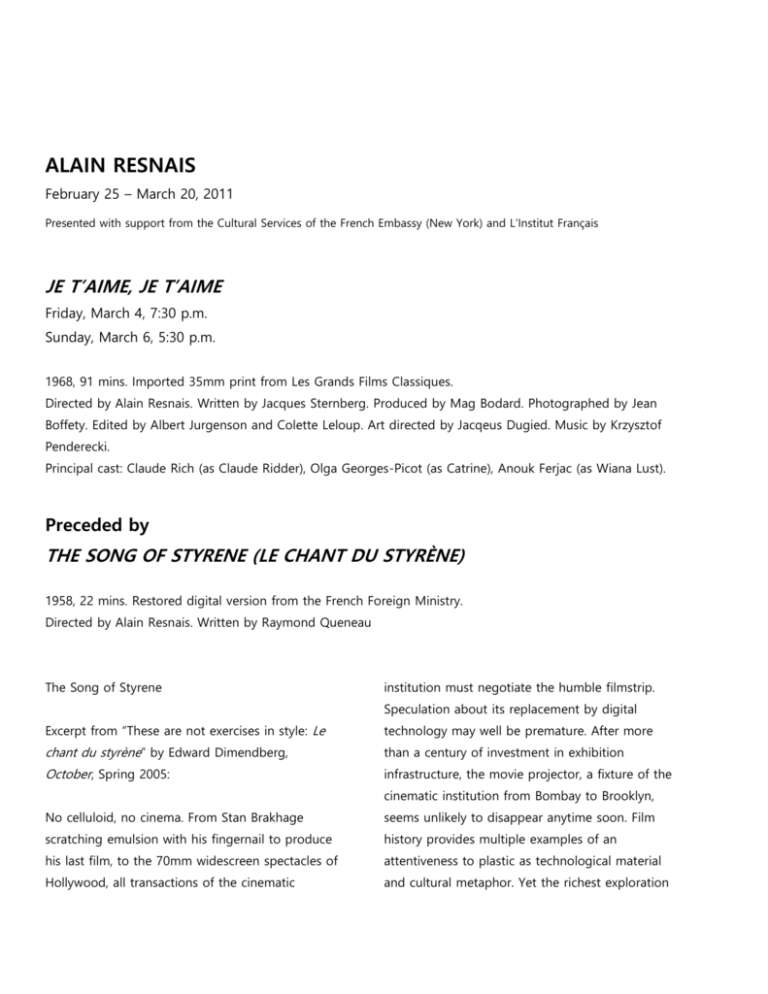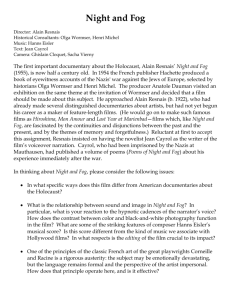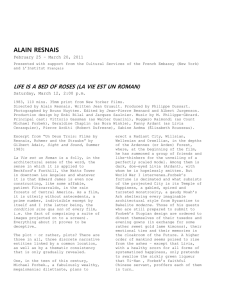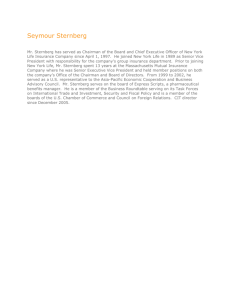JE_TAIME,_JE_TAIME - Museum of the Moving Image
advertisement

ALAIN RESNAIS February 25 – March 20, 2011 Presented with support from the Cultural Services of the French Embassy (New York) and L’Institut Français JE T’AIME, JE T’AIME Friday, March 4, 7:30 p.m. Sunday, March 6, 5:30 p.m. 1968, 91 mins. Imported 35mm print from Les Grands Films Classiques. Directed by Alain Resnais. Written by Jacques Sternberg. Produced by Mag Bodard. Photographed by Jean Boffety. Edited by Albert Jurgenson and Colette Leloup. Art directed by Jacqeus Dugied. Music by Krzysztof Penderecki. Principal cast: Claude Rich (as Claude Ridder), Olga Georges-Picot (as Catrine), Anouk Ferjac (as Wiana Lust). Preceded by THE SONG OF STYRENE (LE CHANT DU STYRÈNE) 1958, 22 mins. Restored digital version from the French Foreign Ministry. Directed by Alain Resnais. Written by Raymond Queneau The Song of Styrene institution must negotiate the humble filmstrip. Speculation about its replacement by digital Excerpt from “These are not exercises in style: Le technology may well be premature. After more chant du styrène” by Edward Dimendberg, than a century of investment in exhibition October, Spring 2005: infrastructure, the movie projector, a fixture of the cinematic institution from Bombay to Brooklyn, No celluloid, no cinema. From Stan Brakhage seems unlikely to disappear anytime soon. Film scratching emulsion with his fingernail to produce history provides multiple examples of an his last film, to the 70mm widescreen spectacles of attentiveness to plastic as technological material Hollywood, all transactions of the cinematic and cultural metaphor. Yet the richest exploration of this scarcely fortuitous linkage between cinema in the world of petit-bourgeois drudgery, and he and its ineluctable material base, a work that was most appreciated for his sense of humor, said transcends modernist self-reflexivity, though it to be absurdist in a dark, Kafkaesque vein. He surely implies that modernist gesture, remains Le made a perfect match for Resnais, whose roots in chant du styrène (The Song of Styrene), a 1958 French surrealism made him sympathetic to industrial documentary commissioned by the Sternberg's worldview, and together they came up French plastics company Pechiney and directed by with a crack surrealist premise: A depressed Alain Resnais with an accompanying narration in bureaucrat, suicidal after a broken love affair, is alexandrine verse written by literary and recruited to be a guinea pig in a time travel intellectual polymath Raymond Queneau (1903- experiment; but when the experiment fails, he's 1976)… The Song of Styrene assumes a place of thrown back and forth through his own memories. prominence in the legacy of the short film, a (If this sounds familiar, that's because it was a medium that bas traditionally been a vehicle for direct influence on Michel Gondry's Eternal philosophical, scientific, or aesthetic inquiry, a Sunshine of the Spotless Mind.) The story was a tendency already evident in the 1920s films by choice vehicle for Resnais' brilliant montage Jean Painlevé and Jean Epstein, up through the strategies, which he had used to Proustian ends in work of 1950s avant-garde practitioners such as his previous Muriel and La Guerre est finie; Oskar Fischinger and Peter Kubelka. according to some, this is the most complex editing scheme of any of his films. Je t’aime, je t’aime Review by Philip Strick, Monthly Film Bulletin, Review by Ben Sachs, Cine-File, November, 2010: August, 1971: Je T’Aime, Je T’Aime is the hardest of the director's Following his slow recovery from a suicide films to see (especially as a print) and thus the attempt, Claude Ridder is released from one clinic most crucial screening for anyone interested in his only to be accosted by two strangers who work. One of Resnais' greatest accomplishments is persuade him to accompany them to another–the his ability to render wholly cinematic seemingly Crespel Research Centre where, under the guises untranslatable authors (Marguerite Duras, Alain of agricultural research, a group of specialists is Robbe-Grillet, Alan Ayckbourn), so the investigating the nature of time itself. Accepting unavailability of Je t’aime, je t’aime in the United their spokesperson’s statement that he has States may have something to do with Americans' nothing to lose, Ridder listlessly allows himself to unfamiliarity with its screenwriter, Jacques be prepared for a journey back into one minute of Sternberg. Little of Sternberg's fiction has been his own past. Enclosed in the curious embrace of translated into English, but in France he enjoyed a the Crespel time machine, with only a mouse (a cult following similar to Philip K. Dick's here. Like seasoned time traveler) for company, Ridder Dick, Sternberg wrote fantastical sci-fi set mainly experiences the first stages of the trip in the form of fragmentary glimpses of the seashore where a suspended, of interrupted sleep, of immanent year ago he had been swimming with Catrine, the death, to whom Ridder returns when he surfaces girl he loved… from the sea (a multiple resurrection dripping with implications), and it is Catrine–with much the same As in Resnais’ previous work, the flashbacks enable casual power as when she pours water over a us to find out what kind of person the central beetle–who drives him back into the sea again… character is while he is making his own Catrine, whom he likens to a beach at low tide… reassessment; but more explicitly than other represents both the impulse and the interruption Resnais films, Je t’aime, je t’aime is concerned less for the flow of his existence; although we are with personal reconciliation that with the struggle given little opportunity to get to know her well, to define and come to terms with the process of the yearning repetition in the film’s title is fully time, which robs one of experience even as one justified by her dominance of Ridder’s otherwise enjoys it. Much of the work of Resnais’ scriptwriter purposeless life. Stemming from this is the parallel Jacques Sternberg, like his novel Sexualis ’95 or theme of the difficulty of keeping in touch with perhaps his best-known short La Brûlure de Mille the world outside one’s skull (another Melvillean Soleils, is concerned with ritualized repetition, with concern). Ridder is constantly on the telephone, conventional behavior upended the better to maintaining a tenuous contact with phenomena examine it, and with an obsessive pursuit of an such as Catrine, that are beyond his control; at unusually ideal woman. Here these elements are one point he even talks to T.I.M.E. itself, droning combined into the figure of Catrine, whose on without attention to his banal remarks. It is no suppositions that, for example, we are all allergic surprise that the most striking image in the film– to the color green or that man was created and it has many that are memorable–is of a specifically to be the servant of cats, reinforce drowning man talking on the telephone. Resnais Ridder’s Melvillean sense that the universe was continues to have much to tell us, if he can only designed to support more vital pursuits than pen- get through, pushing. It is Catrine, with her talk of laws Museum of the Moving Image is grateful for the generous support of numerous corporations, foundations, and individuals. The Museum is housed in a building owned by the City of New York and receives significant support from the following public agencies: the New York City Department of Cultural Affairs; New York City Economic Development Corporation; New York State Council on the Arts; Institute of Museum and Library Services; National Endowment for the Humanities; National Endowment for the Arts; Natural Heritage Trust (administered by the New York State Office of Parks, Recreation and Historic Preservation). Copyright © 2011, Museum of the Moving Image





